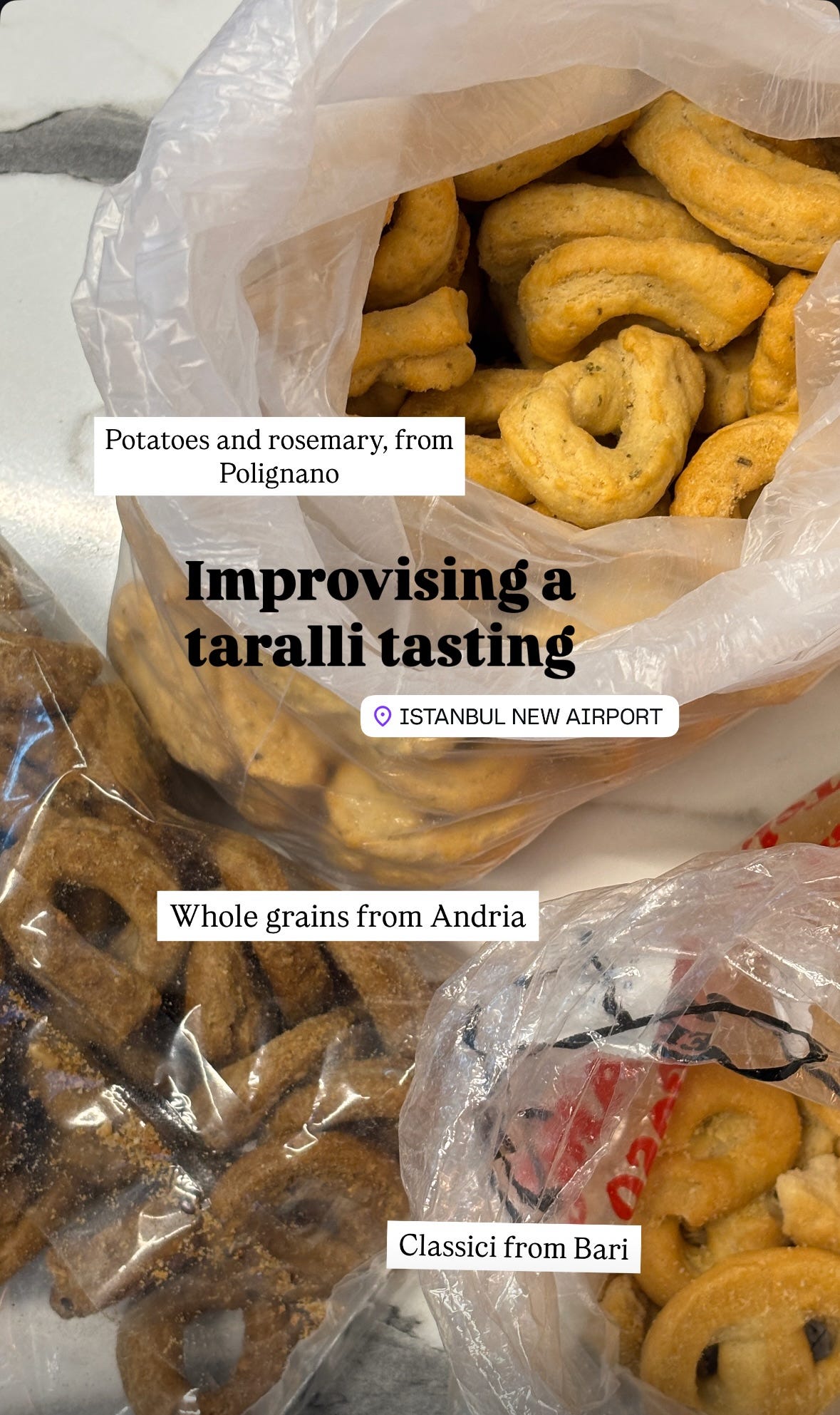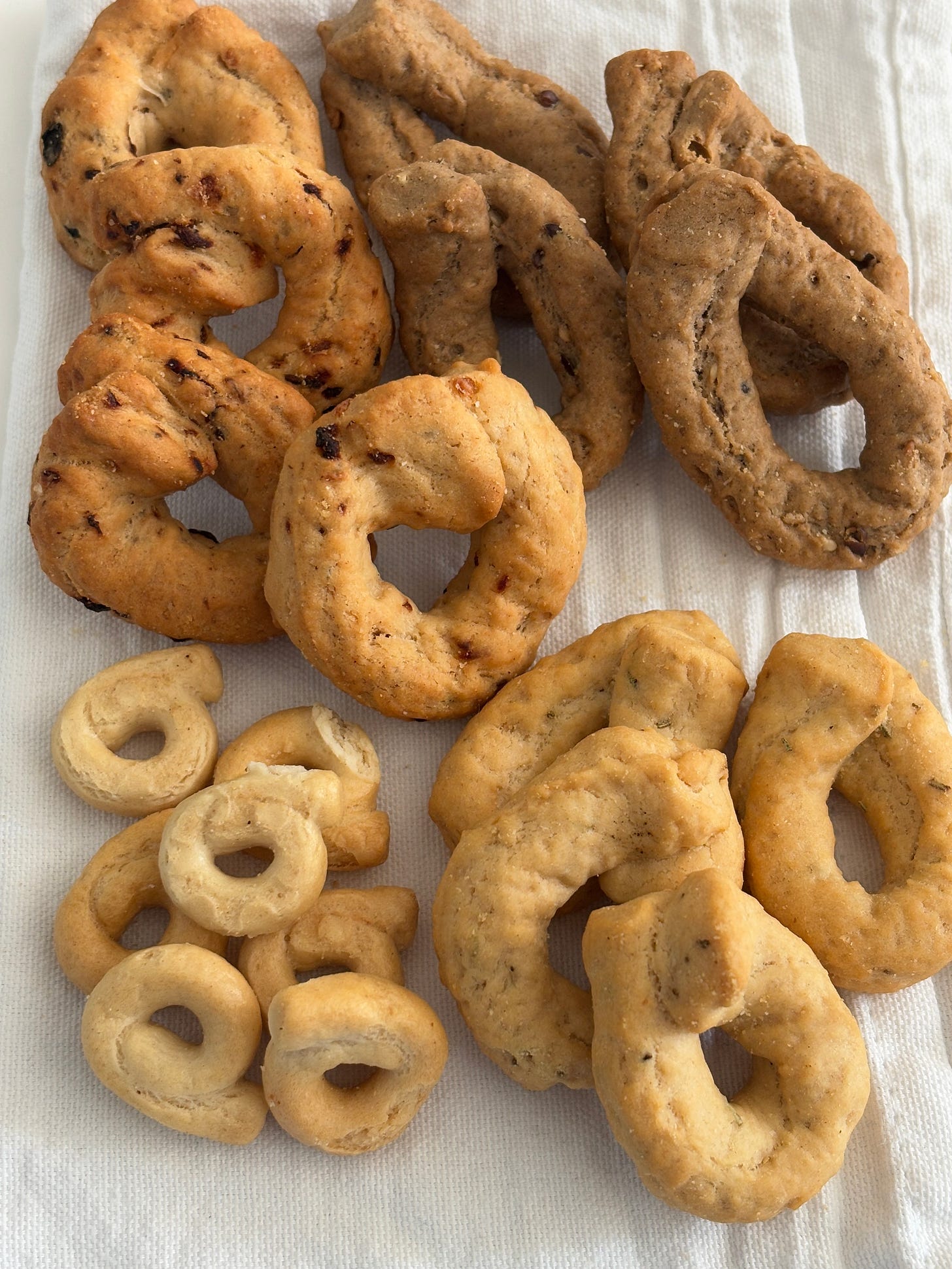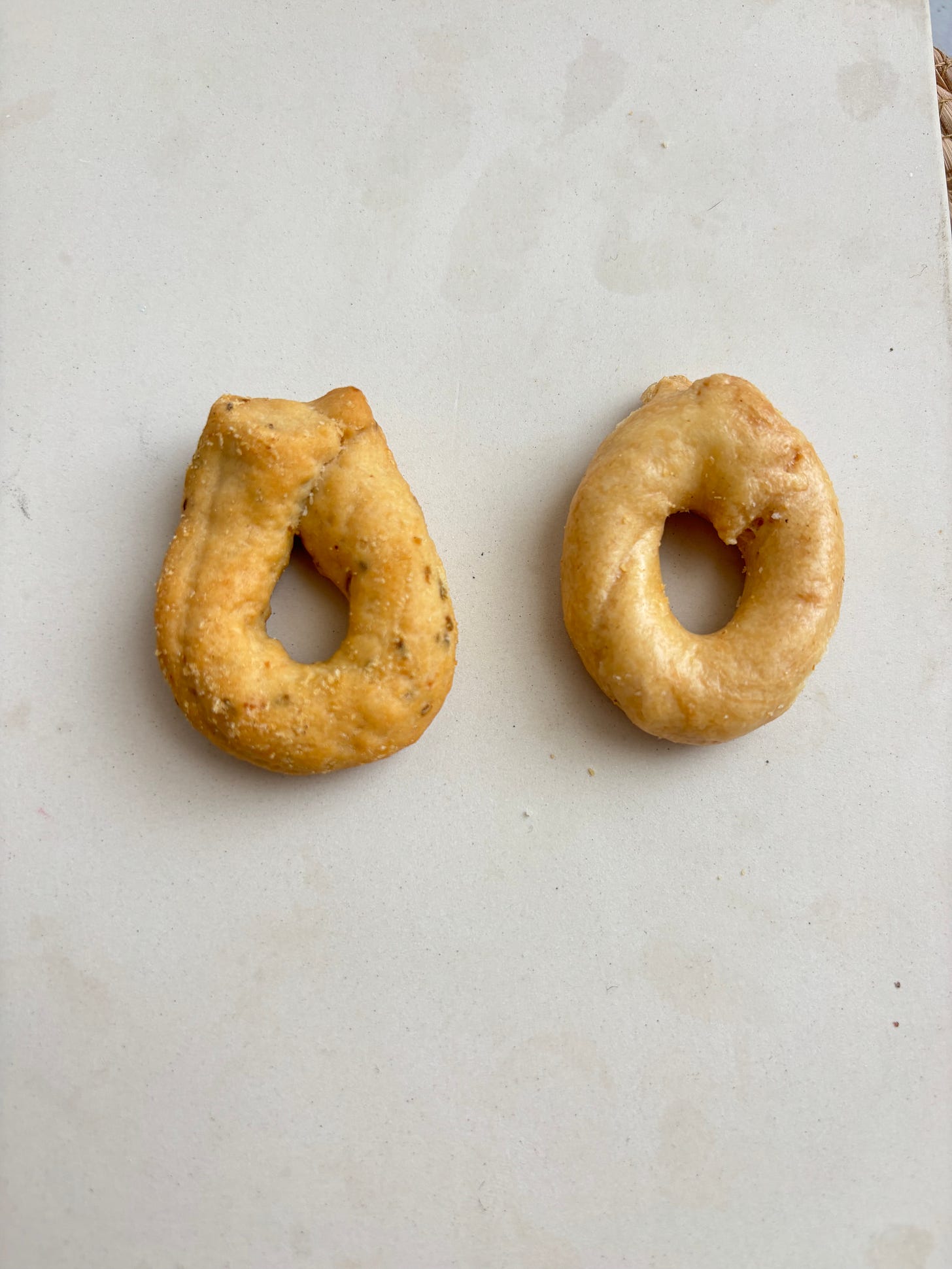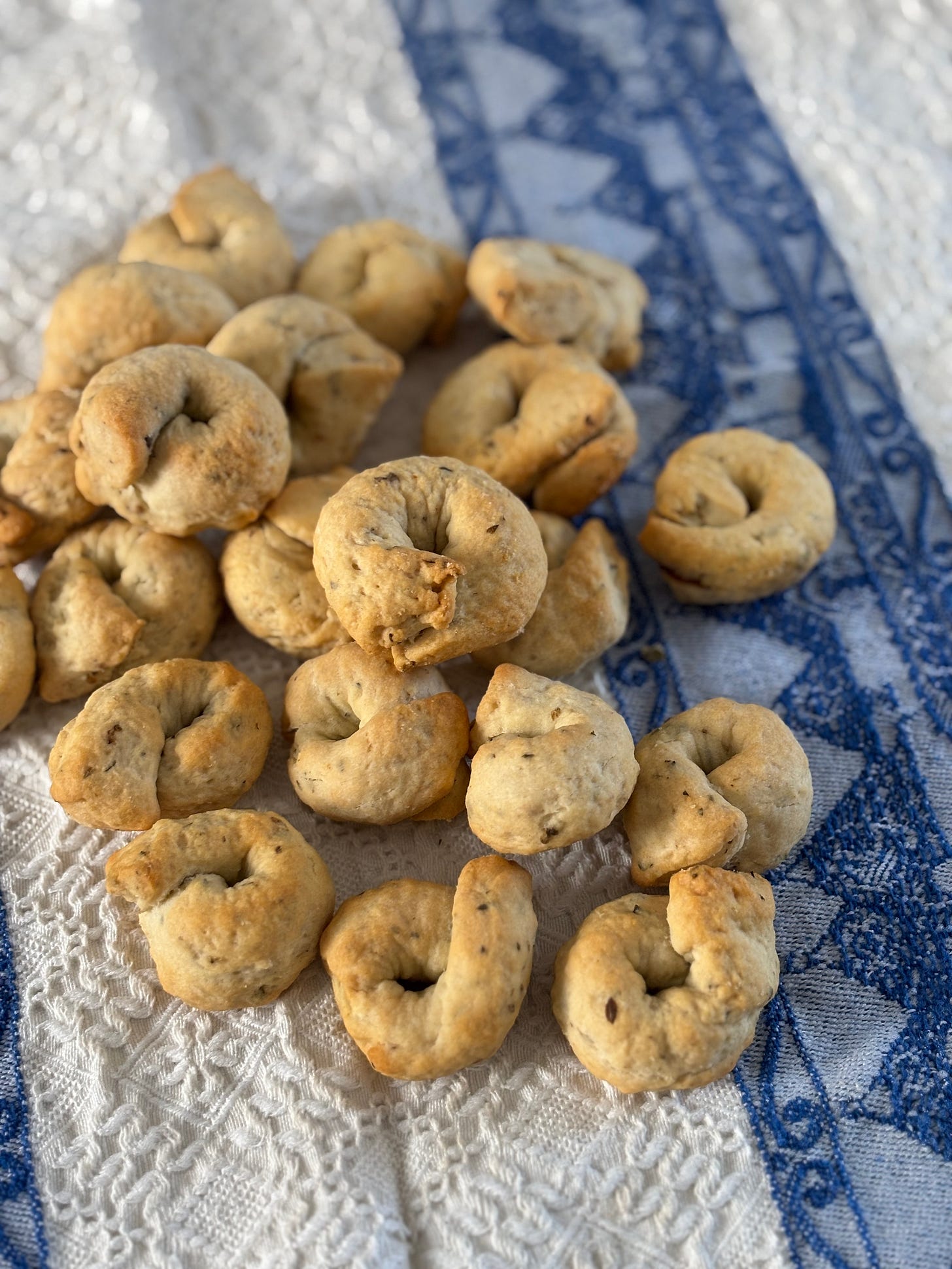I'm writing this newsletter while traveling from Bari to Lecce. I've been composing it mentally since this morning, as I packed my suitcase, ensuring I had everything: a change of clothes for two days, toothbrush, sneakers and heeled sabot, my laptop, and the book I'm currently reading.
In my cotton tote bag, alongside my wallet, earbuds, and sunglasses case, I make sure there's room for a bag of taralli.
This time, my travel companions are long, slender taralli made with burnt wheat, purchased from one of my favorite bakeries: Spacciagrani, an independent bakery in Conversano. On a two-hour journey from Bari to Lecce, while writing this newsletter, I know I'll reach into that bag at least a couple of times to quell the light hunger that strikes around 11 a.m.—too early for lunch, but well past breakfast.
Taralli are the quintessential snack for Apulian travelers: tucked at the bottom of a bag, they've seen more places than one might imagine. They accompanied me to Oman last month when I traveled with two friends—both restaurateurs. The surprise was palpable when, at Istanbul Airport, we opened our bags to reveal three different types of taralli: mine, with potato and rosemary, bought at the Polignano market; Monica's, made with whole grains from a bakery in Andria; and Vezio's, the classici from Bari, with fennel seeds.
At the airport table, while our phones charged as we awaited a connecting flight, we held a taralli tasting session, followed by a lengthy discussion about which tarallo was the best, the criteria for defining it, and where to buy them.
Taralli: the snack for journeys—be they short or long. But they're more than that:
- They were the snack of my childhood, kept in a small plastic container that I opened immediately after the school bell signaled recess;
- The crunchy treat to nibble on the beach between swims;
- The most effective pacifier for any child's crying fit;
- The indispensable accompaniment to any aperitivo, alongside a glass of wine, so much so that it gave rise to the expression "tarallucci e vino" (taralli and wine, which that a quarrel or disagreement has ended with an amicable settlement);
- The food I crave when feeling nauseous—whether from a hangover or a stomach bug—capable of restoring balance to both belly and heart.
Sweet, crunchy, made from a perfect dough: oily but not greasy, crumbly. The secret lies in a balanced combination of water, flour, extra virgin olive oil, and white wine. The latter is essential for imparting the fragrance that makes taralli irresistible and causes them to crumble gracefully. Salt and perfect baking do the rest of the magic.
But what exactly is a tarallo? Where does it come from, and what are its origins?
I hesitate to call it a snack because, to me, a tarallo is a must-have—something that should never be missing at home. A stopgap for every existential hunger. A salvific food.
Taralli are crunchy rings obtained by baking a non-leavened dough made from flour, extra virgin olive oil, and white wine. After kneading all the ingredients, the dough is shaped into small logs, which are then formed into rings. Traditionally, these are first boiled and then baked. Numerous versions exist, flavored with fennel seeds, olives, onions, herbs, and other vegetables. Some variants merge taralli with pizza or onion calzones.
The origin of the name is subject to various theories, none conclusively supported by written documents. According to the Atlas of Traditional Italian Food Products (Atlante dei PAT), the name "tarallo" might derive from the Latin "torrère" (to toast), the Italic "tar" (to wrap), the French "danal" (round bread), or "toral" (drying rack). The most widely accepted theory today suggests it comes from the Greek "daratos," meaning "a kind of bread."
The origin of taralli dates back to the 15th century. The recipe has evolved over time with significant refinements. Firstly, the boiling step was added. The reason? It intertwines with the tradition of communal ovens, which I also discuss in my latest book, PUGLIA.
These public ovens were used until the post-World War II period for baking bread, as not every family had its own oven at home. While bread was the main item baked, the oven could be used before or after for other products. Focaccia, for example, was baked before the bread—a sort of trial run to empirically test the temperature of the oven. Taralli, on the other hand, were often baked after the bread. Like shortcrust pastry, their baking needed to last only a few minutes—just enough to become biscuit-like and golden without burning. Having taralli that were already boiled and thus pre-cooked helped manage the timing.
This mixed technique, involving boiling followed by baking, is reflected in the name "scaldatello," a type of tarallo so named because it's "scaldato" (reheated) in the oven after an initial cooking.
From the 1950s to today, taralli have come a long way: from homemade preparations, they are now a product sold in every Apulian bakery. Evolving from a byproduct of bread-making to a symbolic item, thanks to a mix of deliciousness, quality ingredients, and portability.
How to navigate the world of taralli? To classify them, we must first distinguish between boiled and non-boiled varieties.
The former undergo a double cooking process (as in the case of scaldatelli), which gives them a shiny, glossy, almost slippery crust.
The latter have a rougher, more rustic surface. Boiled taralli are harder and crunchier, while non-boiled ones are more crumbly and grainy.
(non-boiled to the left vs boiled to the right)
Shapes vary: the classic ones are round, ring-shaped; others are oval or elongated.
Then comes the topic of flavorings: the classics are seasoned with fennel seeds, but the variations are countless. They can be made with different flours (soft wheat, semolina, local grains like Senatore Cappelli or Saragolla). Potatoes can also be added to the dough, enhancing the crumbliness. Other additions include chili pepper, sun-dried tomatoes, dried onion, raisins, and herbs like rosemary or oregano.
What truly makes the difference is the ratio between flour, oil, and wine. Altering the balance among these ingredients results in completely different taralli.
I always recommend reading the labels to understand the composition: ingredients are listed in descending order by weight. The best artisanal taralli are made exclusively with extra virgin olive oil. I avoid those made with seed oil, margarine, or lard, as well as those containing yeast, emulsifiers, or preservatives.
Alternatively, I make them myself. Here's my recipe.
Herb-infused taralli
Ingredients for 22–25 taralli:
250 g (1¾ cups) all-purpose flour
60 g (¼ cup) extra virgin olive oil
70 g (¼ cup plus 1 tablespoon) dry white wine
1 tablespoon dried herbs (e.g., oregano, marjoram, rosemary)
5 g (1 teaspoon) salt
Preparation:
1. In a bowl, mix the flour with the herbs and salt.
2. Slowly add the oil and wine, stirring with a spoon.
3. Continue kneading by hand, transferring the dough to a wooden board, until you obtain a smooth, soft, and fragrant ball.
4. Let it rest, covered under the bowl, for about 10 minutes.
5. Divide the dough into four parts, rolling each into logs as thick as a finger.
6. Cut them into pieces about 7–8 cm (2¾–3 inches) long, then join the ends to form rings.
7. Place the taralli on a baking sheet lined with parchment paper and bake in a convection oven at 180°C (355°F) for 18–20 minutes.
8. Remove from the oven and let them cool before serving.
Enjoy your homemade taralli!









I’ve made these a few times switching between red and white wine and different herbs. The recipe I have called for the pre-boiling method. I’m excited to try your recipe with no boiling! I also loved the sweet version that I tried the last time in Lecce. Thank you for sharing, Flavia. I’m looking forward to meeting you in September for our sensory walking tour of Polignano!
I have never heard nor had these. I am going to make them today. I think my kids would love them! Just lovely.